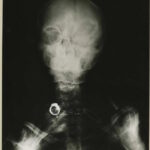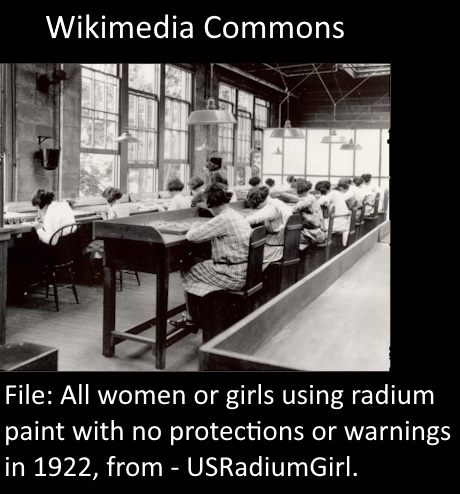The Radium Glowing Ghost Girls
 The Radiant Ghost Girls
The Radiant Ghost Girls
Around the time of World War I, having discovered a radioactive white substance that glowed in the dark, three factories in the United States began hiring women to paint radium onto watch dials. Women and girls were preferred because their smaller hands adapted best for this fine detail work.

Since radiation was being utilized to treat cancer, there was a generalized belief that radium was harmless and possibly even good for one’s health, which is why no one attempted to limit exposure to the paint. The radioactive dust made the worker’s clothing, hair and skin glow. Intrigued by the glow, some workers even wore their dancing dresses to work so the fabric would shine when they went out dancing. It was not unusual for women to apply the paint to their teeth either because this gave them a radiant smile.
By encouraging the women to use their lips to point the tips on their paint brushes, factories found that they could save paint because when rags were used, more material was lost.
Yet, there is evidence that the factories knew of the dangers because the owner and scientists working with it carefully avoided radium exposure by using lead screens, tongs and masks. Male factory workers were apparently told of the dangers of radiation and wore lead screens. Also, this was one of the highest paid jobs for women at the time.
Then workers started developing symptoms. The president of the company reacted by accusing the women of trying to get financial aid for their medical bills. The first woman, “Mollie” developed a toothache which required the removal of a tooth. Then the tooth next to it. She developed ulcers, bleeding and pus which spread to her jaw and other parts of her body. Mollie died of a massive hemorrhage. The company urged doctors to attribute radiation related health problems to other causes. Poor Mollie who died at the age of 24, was declared to have died of syphilis.
Two more years pass with numerous women developing similar symptoms while the factories continued to adamantly deny any connection. Finally, they ordered an independent study which found radiation poisoning. This is where the story should have ended, but the companies hired other studies when had opposite conclusions and were believed to be falsified reports. Data was definitely withheld.
By 1924, fifty women who had worked at the plant were ill with horrible symptoms such as crumbling teeth, collapsed spines, foul breath, pregnancy complications, aching joints, unexplained weight loss, extreme exhaustion, and brutal hemorrhaging. A dozen had died.
In 1925 a pathologist conclusively proved that radiation was destroying the watch painters bodies from the inside out. When the company tried to discredit the man, the woman fought back. Many believed it was too late for them but they moved forward with the hope that they could at least help their fellow workers that were still being exposed.
In 1927 attorney Raymond Berry agreed to accept their case but were basically forced to settle out of court because most had only a few months left to live. The United States Radium Corp went into full denial. The exposure continued and women kept dying. It wasn’t until eleven years later, in 1938, when a dying radium worker named Catherine Wolfe Donohue successfully sued the Radium Dial Co. over her illness, that the issue was finally settled.
The Radium Girls will glow in their graves for a very long time because radium has a half-life of 1,600 years and this radiation is embedded in their bones.






